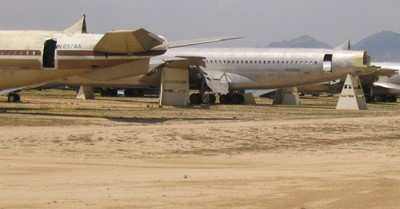"I Can Even Scrap Airliners Better Than You..."
It's no secret Boeing and Airbus continually wage battle over
which manufacturer can sell more planes, and assemble them more
efficiently than the other. But what about when the time comes to
destroy those planes, at the end of their flying careers? To those
familiar with the ongoing Boeing vs. Airbus melee, it should come
as no surprise the two manufacturing powerhouses are increasingly
competitive in this aspect, as well.

Bartin Recycling Group, a French airplane dismantler with ties
to Boeing, claims to be able to recycle almost 90 percent of an old
airliner... but Airbus scoffs at that notion.
"We're doubtful this is what Bartin can achieve," Olivier
Malavallon, manager of environmental affairs at Airbus, told the
Wall Street Journal recently. Malavallon says current technology
only allows about 60 percent of an aircraft to be recycled, though
Airbus hopes to improve that figure to 95 percent by 2015.
 To spearhead that
effort, Malavallon leads a team of experts from Airbus and parent
company EADS working on Project PAMELA -- for Process for Advanced
Management of End-of-Life of Aircraft. Their goal is to find the
most efficient, thorough, and environmentally-safe processes to
recycle derelict planes; the team's testbed is a retired A300.
To spearhead that
effort, Malavallon leads a team of experts from Airbus and parent
company EADS working on Project PAMELA -- for Process for Advanced
Management of End-of-Life of Aircraft. Their goal is to find the
most efficient, thorough, and environmentally-safe processes to
recycle derelict planes; the team's testbed is a retired A300.
Or, more accurately, it was an A300... as little of the actual
aircraft remains today. After removing the plane's empennage
assembly and vacuuming all traces of fluids from the airframe,
engineers used a precise water cannon to cut away the wings. That
method is more environmentally-friendly than more commonly-used
plasma torches, which require a lot of electricity and also vent
noxious fumes. Plus, the team recycles the water.
Next came the removal of the plane's cockpit... and then the
engineers turned their attention to the plane's fuselage. Workers
tested a variety of methods to reduce their section to its most
base elements.
"Unfortunately, the airplane is well-fitted so it won't break,"
Malavallon, ever the faithful Airbus employee, quipped.
The team monitored the time it took each team to perform their
tasks, and specific components such as aluminum skin panels, and
structural braces and fasteners, were separated, weighed, and
stored in bins for analysis. The team is now pouring over their
findings, looking for areas where they could further pare down the
process.
"If we do a good job, Boeing will cut and paste what we've
done," Malavallon said. "We have no problem with that."
Charles Kofyan, who runs Bartin's aircraft recycling operation
in Chateauroux, France -- a few hours north from Tarbes, where
Project PAMELA is underway -- says their operation is already close
to what Airbus is hoping to achieve.

"We do it and we can show it," he said. Bartin is part of a
newly-formed trade group of aircraft recyclers, brought together by
Boeing after a retired 737 was found dumped by unknown culprits in
Scotland two years ago.
"It became a way to get people's attention across the industry,"
said Billy Glover, director of environmental performance strategy
at Boeing, of that incident. Today, the Aircraft Fleet Recycling
Association (AFRA) includes 23 companies, and recycles as many as
150 planes a year in Chateauroux and Tucson, AZ -- near what is
perhaps the most famous aircraft "boneyard" in the world, at
Davis-Monthan Air Force Base.
Aside from protecting the environment, and bragging rights
(after all, we ARE talking about Airbus and Boeing), aircraft
recycling is also an increasingly lucrative enterprise. Components
once left rotting in the Mojave, or cut up and compacted along with
the rest of an airliner, can bring big money on the recycling and
resale markets.

A plane's engines may bring close to $2 million; a cockpit
windshield, $10,000.
 Airbus Racer Helicopter Demonstrator First Flight Part of Clean Sky 2 Initiative
Airbus Racer Helicopter Demonstrator First Flight Part of Clean Sky 2 Initiative Diamond's Electric DA40 Finds Fans at Dübendorf
Diamond's Electric DA40 Finds Fans at Dübendorf ANN's Daily Aero-Term (04.23.24): Line Up And Wait (LUAW)
ANN's Daily Aero-Term (04.23.24): Line Up And Wait (LUAW) NTSB Final Report: Extra Flugzeugbau GMBH EA300/L
NTSB Final Report: Extra Flugzeugbau GMBH EA300/L Classic Aero-TV: 'Never Give Up' - Advice From Two of FedEx's Female Captains
Classic Aero-TV: 'Never Give Up' - Advice From Two of FedEx's Female Captains





